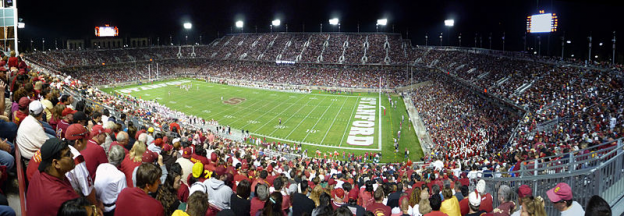Wi-Fi on game day becomes a must-have for college football stadiums

Stanford University became the first college to offer free Wi-Fi in its football stadium in 2011. In the years since, scores of others have followed Stanford’s lead, primarily in response to demand from students and people attending games, graduations and other events in the stadiums.
In a culture where most college students are no more than inches away from their smartphones at any given time and where fans hope to capture every play and every cheer on camera, college athletic and IT directors have realized that connectivity is almost a necessity.
Thus, at collegiate athletic facilities across the country, Wi-Fi and cellular-connected stadiums are becoming the norm. Three examples — at Notre Dame, Nebraska-Lincoln and Stanford — reveal that three different approaches can generate a similar, satisfactory end result.
University of Notre Dame
The University of Notre Dame incorporated Wi-Fi into its South Bend, Indiana, football stadium in 2017 as part of its $400 million “Campus Crossing” stadium renovation. The total renovation included new buildings and in-stadium construction, but Notre Dame found that a relatively simple retrofit — installing handrails in the lower level of the stadium — was a perfect solution.
“We didn’t have handrails in the lower bowl, because the construction happened in the 1930s,” Notre Dame Senior Athletic Director Rob Kelly said. “The handrails helped accomplish distribution of the access points throughout the lower bowl.”
The 1,096 access points on the network have already proven they can handle substantial traffic. In a game against the University of Georgia in September 2017, MobileSportsReport.com measured 6.2 terabytes of fan Wi-Fi traffic during the game — the most it had ever recorded.
“The connectivity has been one of the top three positive customer feedback items throughout the season,” Kelly said.
Check out “21 smart communities to watch in 2018,” produced by our sister publication StateScoop.
Notre Dame is also considering a variety of mobile apps — including those that facilitate digital ticketing and allow access to a Wi-Fi login portal — to improve fan interaction in the near future.
University of Nebraska-Lincoln
When it was installed in 2014, the Cisco-connected system in the University of Nebraska’s Memorial Stadium was the largest collegiate and second-largest Cisco Connected Stadium deployment in North America.
The impetus for such a large renovation, said Dan Floyd, director of IT for Nebraska Athletics, was a fan survey — Wi-Fi connectivity scored highest on a list of desired amenities in the stadium. After an RFP, the university settled on CDW, an IT solutions provider, to build out the network using Cisco’s technology.
With a focus on Wi-Fi connectivity and digital signage, or IPTV, the connected stadium has been a boon for fans, Floyd said. Last season, 35,000 game attendees, or more than one-third of the stadium’s 90,000-person capacity, were on the network at the same time.
Stanford University
Stanford University, a private institution located about 15 miles outside Silicon Valley in California, was the first U.S. university to offer free Wi-Fi in its football stadium. The Wi-Fi network allowed fans to watch replays and observe real-time statistics through their devices, said Jon Erickson, associate director of facilities at Stanford.
“All the students are coming to the game. Great, they’re sitting in their seats or mostly standing — but they’re watching the game on their smartphone,” Erickson said, emphasizing how many students are taking advantage of the stadium connectivity.
Erickson said that Stanford, like other college football stadiums, had to navigate the tricky path of installing antennas in places that wouldn’t obstruct fan views or damage the stadium.
“We had to figure out how to install the antenna equipment in such a way as to not adversely affect the architectural integrity of the facility,” he said.
Erickson said vendors and the university tried several options, including touchpoints under seats in the front row, which health and safety officials ruled out, or antennas within view of fans, which Erickson likened to “putting a Wi-Fi antenna in the middle of a Picasso.”
Ultimately, antennas were placed under handrails inside the stadium, which presented discreet and powerful access to Wi-Fi for fans.
“The problem is,” Erickson said, “it’s never enough. We had to come in two years later and double the number of access points in the stadium, and still people complain [about access].”
To mitigate that, Stanford is looking toward the future: 5G cellular connectivity. The university is in the midst of renovating its antenna systems and has been contracting with cellular providers to get the hardware ready for the next wave of connectivity. Admittedly, Erickson said, Silicon Valley is a place where technology comes first.


